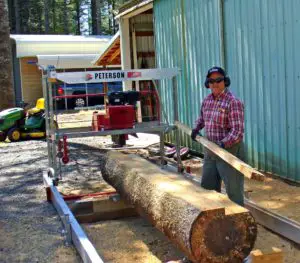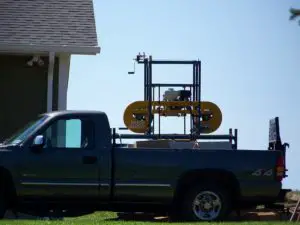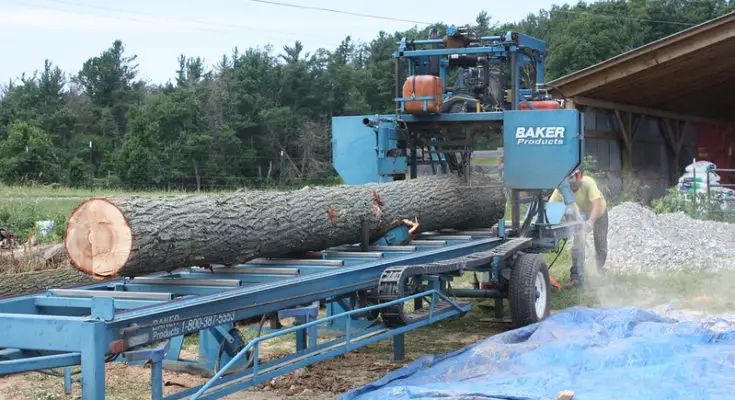For a little over a hundred years, portable sawmills have been an essential piece of equipment for farmers, tree cutters, builders, you name it. Today, little has changed for the handy piece of equipment, seeing a huge boom in popularity in the late 1970s and showing no signs of slowing down. With a popularity due in part to their many advantages like portability, ease of use, benefits to condensing lumber, and so much more, you may have found yourself considering picking one up given all of the above. But there’s plenty of things to learn about when it comes to portable sawmills before you go and decide to bring one home to the farm.
From the different types, what you may need one for, down to the little nuances of what makes a portable sawmill work smoothly for you; today we’ll touch upon all these great basics and more.
Overview of What a Sawmill Can Do
Before you get down to the specifics of figuring out whether a portable sawmill is for you, it goes without saying that you should know just exactly what a portable sawmill can do. Of course, if you already know, read ahead. But, if you’re one of the uninitiated then it’s understandable. There is a level of nuance and skill that comes along with understanding the mechanics of a sawmill, and for those reasons, we’ll explain.
The main duty of a sawmill is to take logs and have them cut into lumber. This is done through a motorized mechanism via the sawmill. Logs are then cut lengthwise.
How portable sawmills work is when logs lay flat on a steel sheet. They are then cut horizontally along the length of the sheet. The operator remains is in full control. Sawmills have the abilities to  help make things like unloading logs from trucks or cars way simpler. Smaller logs makes for easier tasks like rolling of the logs onto a sawmill deck.
help make things like unloading logs from trucks or cars way simpler. Smaller logs makes for easier tasks like rolling of the logs onto a sawmill deck.
Having a portable sawmill can not only save you money, but it can also earn you some money. If you do a lot of woodworking, you can save money by finding logs and cutting the into your own lumber. You’ll need to be able to cut, plane and stores them so they can dry. However, doing this yourself rather than paying someone to do it for you is a huge cost saver.
Having one of these machines can earn you money too because there isn’t a ton of people that own them. Most people don’t have a need to own one. Therefore, when someone has a log they want to cut up, they have to hire someone to either come to their property to cut it up or take the log to someone.
A local guy in my area promotes his business by encouraging people to save trees that need to be cut or were damaged in a storm and make them into furniture. He gets a few jobs every year cutting up an old tree that has been a generational home. Not only does he get paid to come out and cut the tree into slabs, but he usually gets hired by the family to make the slabs into live edge tables for the homeowner and other family members. His customers like the fact that they are saving wood from a tree that has been around for decades and making into a heirloom piece of furniture.
A really good book around the idea of harvesting your own lumber is available on Amazon (Click Here). It’s not expensive, and is a very thorough look at the process and everything you need to consider if you are serious about moving forward with the idea.
Sizes Available
Portable sawmills can come in a wide range of sizes. It really just depends on your needs. If you are looking for a true “portable” saw mill, you can get one that can be towed by a truck. These are great for people that may travel around and cut lumber for customers at their home.
Bigger sawmills are available. They are usually made to remain in one location but can be moved with some work and the proper equipment. The advantages of these units is that they can cut significantly larger logs. The disadvantage is that they aren’t nearly as easy to move.
Some people may not consider them a “sawmill” but one last option available are chainsaw mills. These are the smallest and most portable. They are also the cheapest units available. These work by attaching a chainsaw to a steel jig that allow you to use a chainsaw to cut boards from logs.
How Much Do Portable Sawmills Cost?
Portable sawmills although smaller than their regular sized counterparts are big pieces of equipment. As you’ve been learning, the best place for a sawmill is someone with space. And with a big piece of equipment comes a decently sized price tag.
The average cost of a sawmill will depend heavily on how big of a saw you need. You can pick up the small chainsaw mills I mentioned above for as little as $150 (plus the cost of the chainsaw). A trailer type saw mill will cost can cost as little as $3,000 and go on up to $60,000. The more stationary types of portable mills can go from $20,000 and on up into the 6 figures.
Why would you need a sawmill and who should buy one?
One of the main reasons anyone picks up a new sawmill is usually for doing work on their property or business. If you need to perform wood work on a daily basis on your farm or for your customers then a portable sawmill is probably an optimal choice. When it comes to what type of work we’re talking about, it’s lumber related. You probably don’t need a portable sawmill if you only find yourself cutting wood every six months. But, if your property or business relies on fresh material on a daily basis, weekly or even bulk shipments monthly, then a portable sawmill may be in the cards.
Portable sawmills make things convenient from getting the job done all the way down to their portability. It cuts down the strenuous activity of cutting wood manually. If this is something that you feel would enhance your work rate or daily tasks then
What are the different types of sawmills?
About 400,000 years ago historians say that the first sawmill came into existence. It’s definitely safe to say that between now and 400,000 years, the different types of sawmills have grown substantially. From finding just a small hut with logs thanks to bronze axes, waterwheel sawmills in the Roman era, all the way down to the electric type portable sawmills we see today on farms, there have been a plethora of types overtime. Some different types of sawmills to take note of are: stationary mills, steam powered mills (rarely used anymore), hand saws, pit saws, up-down sawmill, just to name a few.
Next we’ll take a look at the two most common types of sawmills on the market today. When browsing for a new sawmill for your property, these are usually the two types you’ll have to decide between. The two types are known as circular sawmills, and bandsaws. Note: I’m also going to throw in the distant cousin portable sawmill – the chainsaw.
Circular
Circular sawmills stand opposite to the direct to band type sawmills. They have a few differences but obviously the end result remains the same. It all boils down to which type you prefer working  with over the other. A circular sawmill has a large saw blade that you’ll pass your logs thru. It’s not much different that a large table saw. The key difference in a circular vs bandsaw model really comes down to waste.
with over the other. A circular sawmill has a large saw blade that you’ll pass your logs thru. It’s not much different that a large table saw. The key difference in a circular vs bandsaw model really comes down to waste.
A circular saw blade is about 2.5 times thicker than a bandsaw blade. This causes the blade to cut away more of the log and turn it into saw dust. Using these blades is going to cause your waste to be higher because each pass of the blade is going to cut away about .15″ more of wood.
Obviously if more wood is being cut away, more saw dust is going to be created as well.
Another pro for the circular setup is that you can get higher production out of these saws versus the bandsaws. You can cut quite a bit more wood in a day using one of these saws over it’s counterpart.
Band
Bandsaws are the direct alternative to circular sawmills. With bandsaws the differences that set them apart are pretty much just having a blade which is a thin band of metal. That metal is welded together which in turn forms a circle. This is where the model is somewhat similar to the circular sawmills but you can also see where the differences lay in structure.
To get a bit more technical, bandsaws have a thinner kerf. A kerf translate into the size of the width once the wood is cut. Also with a bandsaw you see far less dust and debris while cutting. This can be optimal if you want to avoid any possible breathing irritation. With less dust and debris you see far less waste accumulation when it comes to bandsaw models as opposed to circular.
One of the positives of a bandsaw setup is that you’ll have less sawdust. However, these boards typically need more planing to get them smooth because of the movement that occurs with a bandsaw blade while it’s cutting thru the log.
Another positive for a bandsaw mill is that it requires much less horsepower to operate which translates into less fuel being used to operate.
Chainsaw
Again, these aren’t really considered in the same group as the other two sawmills, but I think it’s important to cover them. These types of mills are great for people that aren’t going to cut up a  bunch of logs all the time. They are also great because you take them to a fallen log and just start cutting on it. No need to move the heavy log or reposition it.
bunch of logs all the time. They are also great because you take them to a fallen log and just start cutting on it. No need to move the heavy log or reposition it.
The downside to these setups are that they do cost a decent amount of money to get all the parts needed to get up and running. Like I said before, a cheap mill framework can be found for less than $150 on Amazon (Click here to see). However this is just part of the cost. You’ll also need a strong chainsaw to do these cuts. It’s not out of the question to pay another $500 – $1,000 to get a chainsaw good enough to do these cuts.
The other major drawback to this setup is the labor needed to operate. If you cut a log up with one of these, you will be exhausted when you are done. The chainsaw mills will wear you out. Again, if you aren’t doing it often, it’s not a problem. It’s not practical though to think you can do this all the time.
Servicing and Maintenance
The servicing and maintenance is relatively the same across each of the mills we covered. Circular saws are generally cheaper to operate over time. Chainsaw mills are the most costly because of fuel and bar oil that will be needed to ensure your chainsaw doesn’t overheat.
Cleaning your sawmill from time to time can not only make it look great from a purely cosmetic standpoint, but it can also help keep your machine running efficiently. The key to keeping any piece of equipment for the long term is making sure all its components are well kept, which means that cleaning and servicing your sawmill can be paramount. Below are some tools and tips you can use to keep your new or old sawmill running as best as possible.
Pressure Washer
Pressure washers or sometimes known as power washers are great tools to clean your sawmill with because they get in those tricky and hard to reach areas that regular water would otherwise roll right off of. The pressure of the waters is a thorough way to get off all the dirt, grime, and sawdust. One thing to be careful of I’d getting water inside your sawmill though. You’ll want to avoid the fins of the radiator for this reason or you’ll damage the interior components.
Leaf Blower
Leaf blowers are great for one thing when it comes to sawmills and that’s for saw-dust. sawdust can build up quickly over time and things like a vacuum can’t always get into those hard to reach places. A leaf blower has the power and versatility to get out all the dust easily.
And there you have it. From what are the reasons you would buy a sawmill, how sawmills work, their pricing, and more, today you’ve learned all you need to know about buying a portable sawmill. Remember to always work under safe conditions free of any medications or illness that may cause injury and you’re good to go!
Is a Portable Sawmill Worth It?
Ultimately, this is going to be dictated by your situation. If you are regularly cutting logs, then yes, it will benefit you to get a portable sawmill. These saws make cutting logs far easier than any other method. They are very dangerous, just as any saw is, but with proper training and respect for the machine, you can safely operate one.
If you are looking to open a sawmill and start earning some income with it, I’d encourage you to not jump in too deep. If you are just starting out, try to pick up a used portable mill or buy an inexpensive one until your business grows and becomes consistent. Like most purchases, the value of a sawmill will depreciate over time. You’ll see a drop in value on a sawmill when you buy a new one the first time you cut with it, because it’s now “used” equipment.
How Much Can You Make With A Portable Sawmill?
This answer will also completely depend your specific situation. The number of customers in your area and the amount of access you have to logs will play a significant part in the total amount of money you can make with a portable sawmill.
It’s not unrealistic to make $40,000 a year if you are able to find consistent business. If you are willing to work most Saturday’s in a year, you could easily see your income grow to $60,000 – $70,000 per year. Again, this will depend on many factors and before jumping in too quick and making large purchases, I’d suggest you spend a considerable amount of time researching your numbers and getting a feel for the demand for a portable sawmill in your area.




